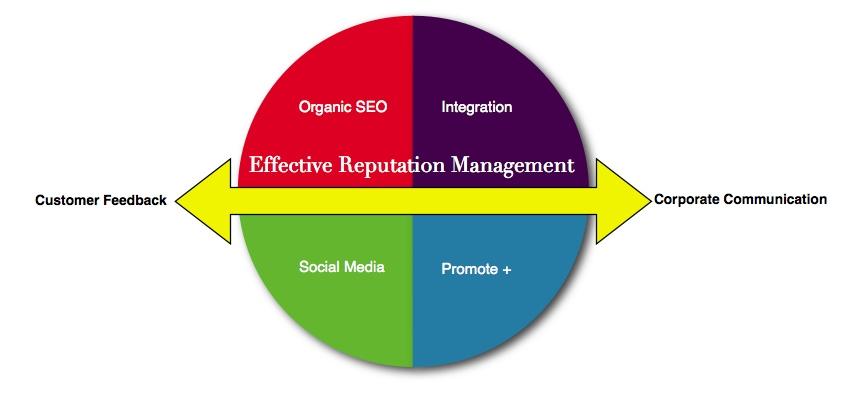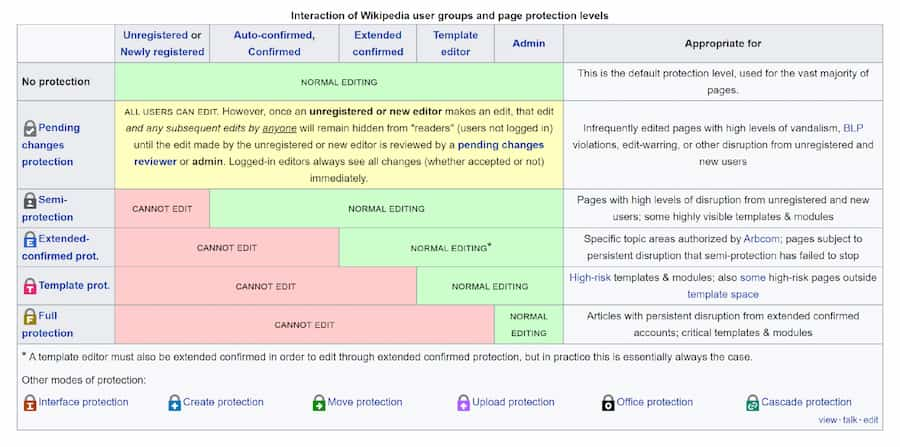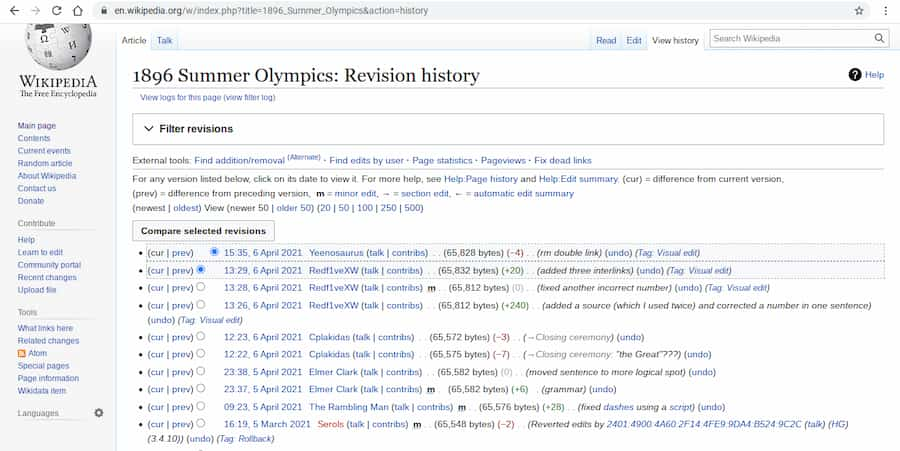How to Know Who Edited Your Wikipedia Article
Key takeaways
- What Wikipedia says about you matters a lot
- Despite the setup of Wikipedia as an open-source program, not just anyone can edit everything
- Seeing who edited a Wikipedia article helps with transparency and understanding the power dynamics of an article
- Wikipedia can have a big effect on online reputation, managing it can help you curate what people see about your brand.
Wikipedia is one of the world’s most powerful websites. What Wikipedia says about you or your company can have a big impact, which is why many companies and organizations have tried to spruce up their own Wikipedia articles – sometimes with disastrous effects.
Since its inception, Wikipedia has grown from a truly ‘open-source’ platform to an oligarchy where influence matters, and some editors have exponentially more pull than others. To understand and get an insight into these power dynamics, it is vital to know who edited a Wikipedia article.
Importance of Wikipedia for company reputation
Many companies realize the importance of Wikipedia – it is why Wikipedia management is a core part of corporate reputation management strategy. Most companies want to have their own article or want to exercise some degree of control over their Wikipedia article – and why not? They know more about their company than anyone else – but Wikipedia isn’t set up that way.
References from Wikipedia are widely sought after for publicity, but the information itself that appears in a Wikipedia article is an important part of any corporate reputation program.
Source: Wikimedia Commons
Because of the power and influence that Wikipedia articles can effect on your company, it can be very tempting to create or edit your company’s Wikipedia article. Editing your own Wikipedia article is socially frowned upon, against Wikipedia’s rules, and can even hinder future efforts—pages with a higher amount of suspicious activity become harder to edit down the road.
Reputation X recommends you don’t edit your own Wikipedia article yourself. This can trigger a “COI” or Conflict of Interest which gets your edits reversed and a big message on your Wikipedia article saying the information may violate policies. However, that doesn’t mean you completely give up control. It just means that you work with the system. In that system, knowing who edited and created a Wikipedia article makes all the difference for Wikipedia management.
Not all Wikipedia editors are the good kind
Knowing who edited or deleted your Wikipedia article can inform you as to the best way to proceed. Most Wikipedia editors are honestly good people who are doing their best. But not all of them. Having an idea as to whom you’re dealing with can make all the difference.
For instance, some extremely authoritative Wikipedia editors actually run their own PR practices on the side and perform paid editing. To make it seem like they are not paid editors they regularly nominate articles for deletion, look for fake editors (sock puppets) and expose them – not always accurately, and work hard to make it seem to other editors they are honest players. But they’re actually running highly profitable paid editing practices.
Other editors have an axe to grind. They don’t like companies they disagree with to reflect positive information about the brand. So they find ways to reverse factual and relevant references with positive brand sentiment. In theory, these editors edits will be balanced out by other neutral editors, but not in practice. This is because the editors are powerful and well-regarded administrators of various types. They’re essentially “made men”. So their edits aren’t challenged for fear of retribution.
Editing Wikipedia: Theory vs. practice
The theory behind Wikipedia is that all people can contribute. Anyone on the internet can make or suggest edits to existing articles and create new articles. You don’t even need an account with Wikipedia to start working on the platform; you simply can start editing with your IP address.
While this is all technically true, it has misled many people and organizations into thinking that editing a Wikipedia article is a ten-minute chore. In practice, creating and editing Wikipedia articles is a much more involved and stringent process with many pitfalls and hidden traps to avoid.
For starters, Wikipedia has numerous bots scouring its articles looking for suspicious additions and edits. Around 1,000 articles are deleted each day on Wikipedia, and the Wikipedia community is always on the lookout for any conflicts of interest on the articles.
Pages with suspicious activity can be assigned some level of protection, blocking certain users from making changes to an article. In other words, not everyone can actually edit them.
Depending on the level of protection, these measures can block anyone from newly registered users to users with less than 500 approved edits. Combined with the bots and sometimes overzealous editors, the theory of ‘anyone can edit’ can quickly turn into practical quicksand.
Telling who edited a Wikipedia article
To keep an eye on the unbiased nature of the articles, all edits are made publicly. Knowing the edit history of any article gives you an insight into who’s editing which articles and who took a stake in a given article.
If you’ve considered editing your own Wikipedia article to polish your reputation a little, you’re in good company: Newt Gingrich and members of the Dutch royal family are just some examples of the hundreds (if not thousands) of people accused of meddling with their own Wikipedia entries.
Start with the article history tab
The first and most important tool in finding out who’s been involved with editing a Wikipedia article is the article’s history. This history is found above the text of the article and shows exactly which changes were made when and by which user. Clicking on the user shows the profile, which helps people identify their interest and their edit history. This first overview helps you identify the different stakeholders in the article.
How the NYPD and FBI were caught
Unregistered users show up with an IP address only. Anyone can look up the location of an IP address, down to the zip code. Although looking this up may not identify the precise computer or person that made an edit, it outed FBI and CIA agents after it was found that edits to articles on Guantanamo Bay were made from FBI and CIA computers.
It also fingered the NYPD after edits of the articles on the controversial and deadly arrest of Eric Gardner were found to have been done from their computers. Technically, that means that you could be regarded as suspicious if your next-door neighbor edits your article, but what are those chances?
Registered users are even more out in the open. Although not everyone can simply look up the IP addresses of Wikipedia users, administrators can. And often enough, a user’s history speaks volumes. Suspicious activity is quickly spotted and can lead to an investigation or a ban of a user.
These insights make the editing history article of a Wikipedia article a powerful tool in understanding Wikipedia, who edited any particular article, and the power dynamics that can be at play. Not every article is hotly contested, but the moral code on Wikipedia can make it a minefield for inexperienced editors or business owners who come to Wikipedia with an agenda.
The CheckUser tool
From Wikipedia:
The CheckUser tool is used by a small group of trusted Wikipedia users (called Checkusers). The tool allows its users to determine from Wikipedia’s servers the IP addresses used by a Wikipedia user account, as well as other technical data stored by the server about a user account or IP address.
When Wikipedia says “other technical data” they are talking about “fingerprinting“. Fingerprinting is really creepy. Fingerprinting is when a browsers screen resolution, cookies, IP address, computer type, operating system type, and more are used together to identify a person even when their name is not known.
Even if you don’t know the name of someone, you can find out a lot about them by the way their computer is set up and how it is used. This information is often transferred to Wikipedia when you access the site.
Paid editors and fingerprinting
Professional paid editors tend not to get fingerprinted, at least not if they are any good at their job. Reputation X can state from experience that a large number of people accused of being paid editors (sock puppets) are in fact not. A few weeks ago we got a call from a woman who was at the end of her rope after her account was banned for being a sock puppet. She wasn’t, but her year-old account was banned mainly because of her noob editing style. Since the person who banned her was a very well-known editor we told her nothing could be done beyond what she had already tried.
Reuse of usernames can help identify Wikipedia users
One tactic that sometimes works when trying to identify who made a Wikipedia edit is when a registered Wikipedia user uses the same handle they’ve used in the past for social media or email accounts. These can be searched in Google and can help to identify who a user is in real life.
Honeypots can give you some information
Honeypots are ways to identify a user online by baiting them to click on a link. When they click on the link they arrive at a web article. The web article tracks their IP address and other data and can sometimes leave a cookie on their machine. One way to partially identify a Wikipedia user is to create a honeypot, something they are compelled to click on.
If the website they end up at, or just a web article, is set to be invisible to Google then no one else should be accessing the article. The one and only user who does must be the person who clicked on the link.
Honeypots can help identify bad people online and are especially helpful for corporate reputation clients who suspect a competitor is weaponizing their Wikipedia article by identifying where the editor is located. If it’s in the same city as the competitor it can provide a clue as to whom is defacing their article.
Wikipedia article editing FAQs
Can Wikipedia edits be traced?
Wikipedia edits can always be traced back to either an IP address or a username. Usernames are generally less conspicuous and harder to track, but administrators on Wikipedia have special tools that allow them to find out who’s behind a username.
Who edits Wikipedia articles?
Wikipedia is edited by hundreds of thousands of editors who can simultaneously work on the online encyclopedia’s articles. You can see which user edited a certain part by checking the history of an article.
How can you tell when a Wikipedia article was last edited?
Every Wikipedia article has a revision history article that shows the precise moment of each edit. You also can see previous versions to compare the article before each edit was made.
About the author
Kent Campbell is the chief strategist for Reputation X, an award-winning online reputation management agency. He has over 15 years of experience with SEO, Wikipedia editing, review management, and online reputation strategy. Kent has helped celebrities, leaders, executives, and marketing professionals improve the way they are seen online. Kent writes about reputation, SEO, Wikipedia, and PR-related topics, and is an expert witness for reputation-related legal matters.
–
Tags: Corporate Reputation, Reputation Marketing, Wikipedia.



